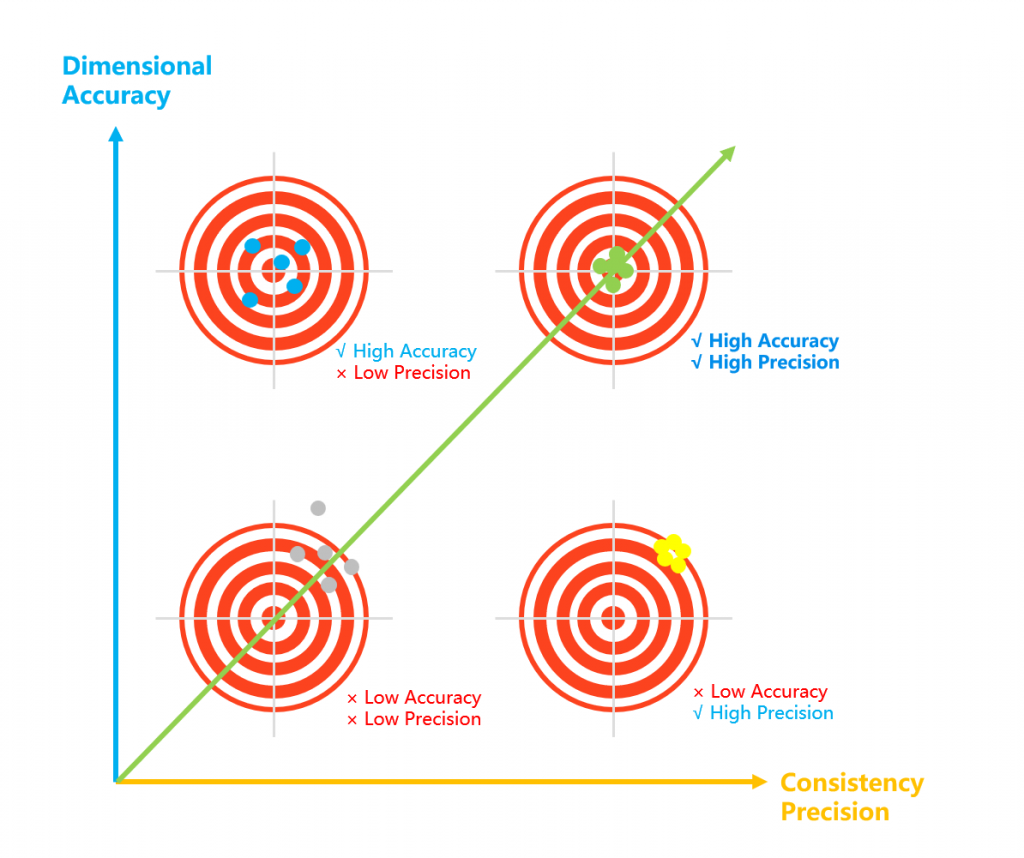Mainstream media has never been more focused on 3D scanning, and people have discovered that it is possible to capture data from the real world and bring it into the digital universe with this technology. 3D scanning is revolutionizing the way products are designed, engineered, manufactured, inspected and archived. Companies around the world are using 3D scanning to increase productivity and eliminate unnecessary costs, and create new and exciting products.
“3D scanning is the process of analyzing a real-world object or environment to collect data on its shape and possibly its appearance (e.g. color). The collected data can then be used to construct digital 3D models.”
—Wikipedia
In the 3D Scanning 101 series, you will get to know the basic concepts of 3D scanning, some must-know jargon in 3D scanning and common 3D reconstruction methods. Hopefully, you will bear this useful guidance in mind when you are stuck in the midst of all the complex information.
But before that, let’s start with some basic concepts to make sure we are on the same page.
Table of Contents
3D Reconstruction Methods
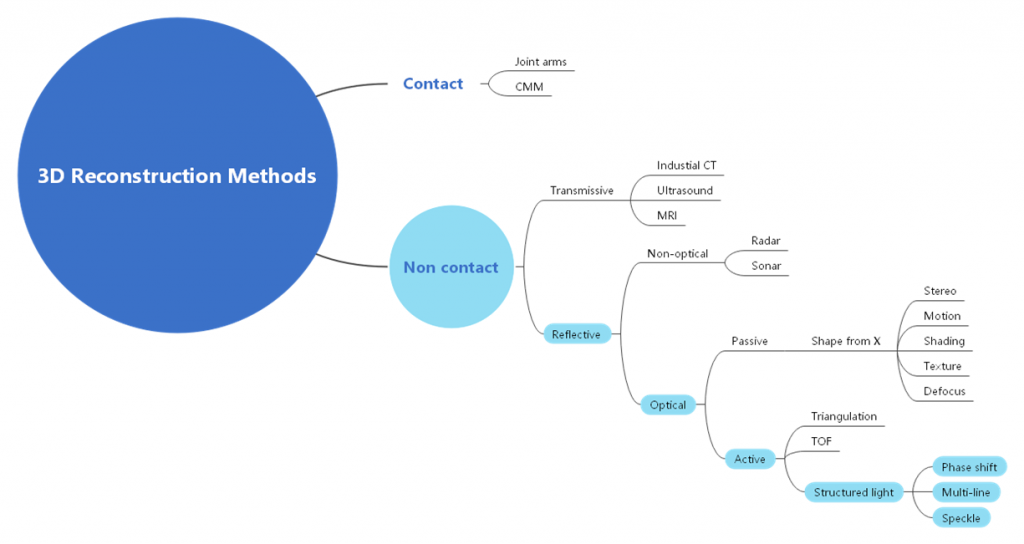
3D reconstruction methods
In the computer vision area, 3D reconstruction is the process of reconstructing the original 3D information from a single view or multiple view images. Common 3D reconstruction modes are: CMM, TOF, sonar, CT, etc. These modalities are widely used in various fields of life. In this article, we will only elaborate on the blue clue part of the diagram above, which is the area SHINING 3D is currently working on.
Get to know the structured light 3D scanning
Types of structured light
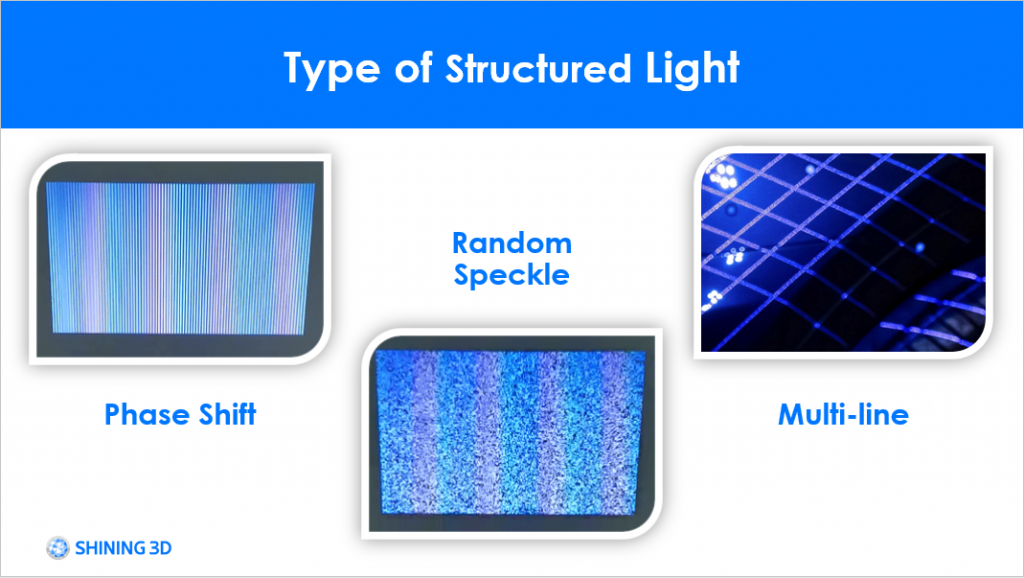
Types of structured light
There are 3 different structured light patterns: phase shift, random speckle, and multi-line. The first one, phase shift, is widely used by fixed scanners. It can produce light in the pattern of a series of gradient moving stripes. The random speckle and multi-lines, on the other hand, can acquire data at a higher frame rate, giving the ability to scan while moving. Thus, it is mostly used for handheld scanners. And the difference between them is the pattern of light they produce. Random speckles produce a repeated, QR-code-like light pattern while multi-line, as the name might have told you, produces parallel lines by two laser projectors.
Point Cloud & Mesh
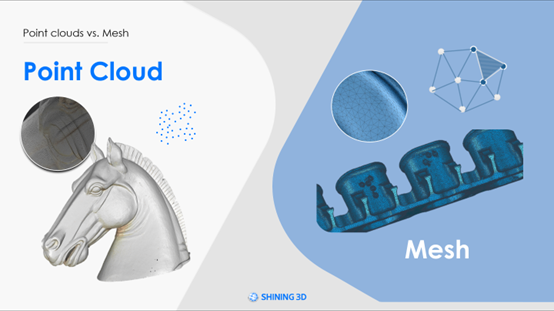
Point cloud and mesh are the outputs of scanners
Point cloud
It is the raw data of scanners and has less post processing. If you have high-quality scan data, the point cloud can be used for metrology inspections as it can provide more original data.
Mesh
The mesh connects all the points you obtained on the point cloud. It reduces noise to form a smooth model for 3D printing and reverse engineering. Most post-process software, like SolidEdge and Geomagic Essentials, can work with mesh.
Types of 3D Scanning Light Source
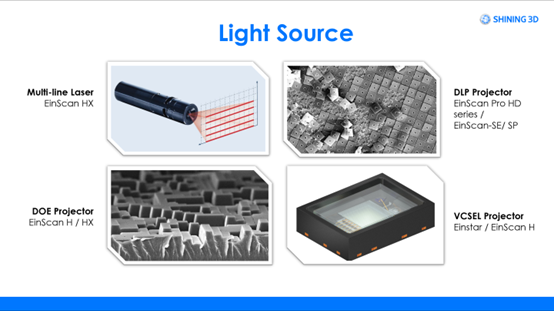
Types of Light Source
These are used for projecting parallel light and can be found on SHINING 3D EinScan HX Hybrid Lights 3D scanner and many other industrial scanners.
DOE
DOE, the abbreviation of Diffractive Optical Elements, refers to the pre-curved pattern on the glass of the scanner. Behind the glass you will often find a LED which allows the scanner to produce light in a certain pattern on an object. Although it can only project one pattern at one time, it has low energy consumption and heat generation. We usually use it for speckle pattern and in the Rapid Scan Mode of EinScan H and EinScan HX Hybrid Lights 3D scanners.
DLP
The Digital Light Processing (DLP) projector can project different types of structure light pattern and so is used by many scanners including EinScan Pro HD Multifunctional 3D scanner, EinScan-SE/SP Desktop 3D scanner and Transcan C Multi Scan Range 3D scanner. For example, the EinScan Pro HD Multifunctional 3D scanner with DLP is able to produce both phase shift pattern and speckle light.
VCSEL
Vertical Cavity Surface Emitting Laser, VCSEL in short, is a kind of laser projector used by Einstar Portable 3D scanner and EinScan H Hybrid 3D scanner. When compared to multi-line laser, VCSEL is different in structure, smaller in size, and consumes less energy.
Scan Data quality: Detail VS Accuracy
Detail and accuracy are a set of very important concepts in 3D scanners but often misunderstood because different applications have their own focus. People usually say they want good scan data. However, when they mention “good”, it could be referring to accuracy, or detail, or even both. Below we have two cases which have different focus.
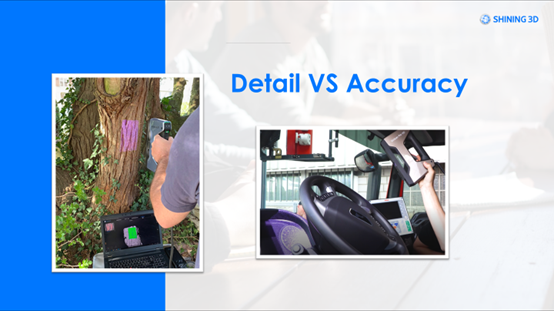
Detail VS Accuracy
Detail
In the photo on the left, we are scanning a tree trunk to design jewellery. For this application, details are more significant since you only need the texture and features of the tree instead of the size of the trunk.
○ Detail-oriented Enhancement Technology: This feature is built into the scanning software and brings better data quality, providing good point cloud density for high resolution through Data Quality Indicator. It is now available on the Einstar Portable 3D scanner and the EinScan H Hybrid Light 3D scanner.
Accuracy
The accuracy is the closeness of the measurement results to the true value. ISO calls this trueness. Alternatively, ISO defines accuracy as a combination of random error and systematic error. For applications such as automotive tuning and industrial manufacturing, accurate data is undoubtedly crucial.
○ Precison
Also known as repeatable measurement accuracy, which means the degree of stability (conformity) between measured values under the same conditions, measured several times over. Like an athlete shooting at a target, a quality player can consistently hit the center area. The accuracy of the 3D scanner can be compared to the hitting area of a target, and the precision to the stability of the performance of multiple hits.
Back to our case, in the photo on the right, we are scanning a car interior for modification. And in this situation, accuracy is much more important than detail. As when you are doing reversed engineering, you would like to make sure the part you designed has good accuracy so that you can assemble it to the original object easily.
Do you now have a better understanding of the basic concepts of 3D scanning? For more details, you may refer to the recording webinar, and stay tuned to our following webinars!


